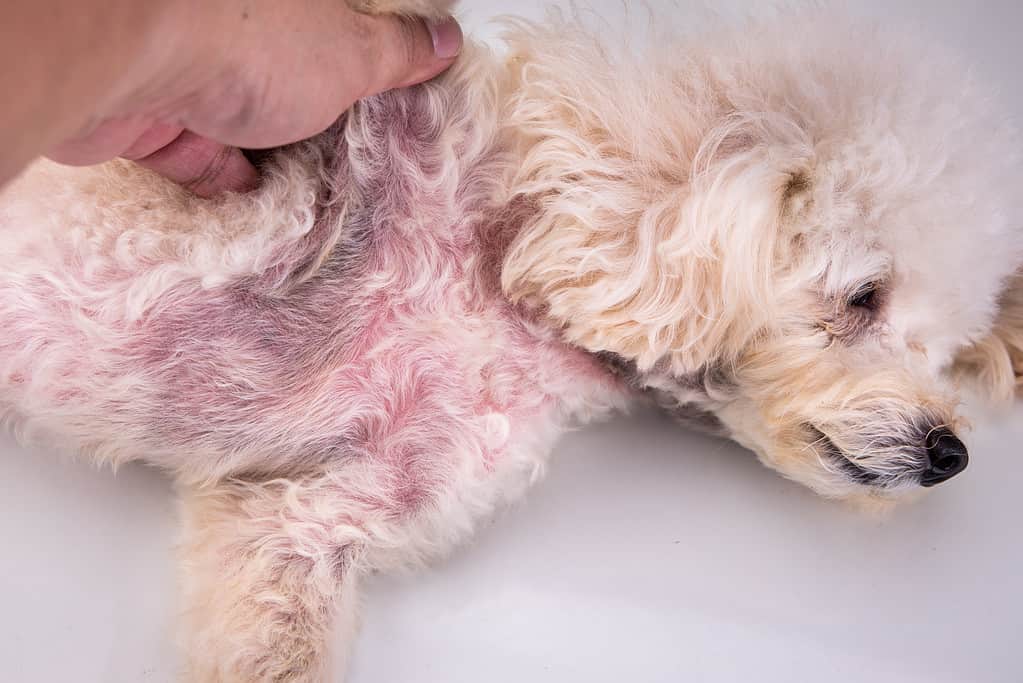Our furry friends can get blackheads from excess sweat or oil on their skin. It’s the same thing that happens to human skin when our pores are clogged. You could find a small pimple or a blackhead on almost any part of your dog’s body, but they are often found on the face, back, or belly.
There are a few reasons as to why dogs get blackheads. While some serious conditions can cause them, they are more often simply the result of dirty, oily skin. If you’ve noticed some differences in your dog’s skin, make note of any symptoms you see and tell your veterinarian. Here’s what blackheads look like on dogs, as well as information on treatment and possible causes.
What Do Blackheads Look Like On Dogs?
On dogs, blackheads look pretty similar to how they do on people. Usually, blackheads appear as a small black dot somewhere under the chin, on the softer belly skin, or along their backs. Because some dog breeds have thick fur, blackheads may not be as easy to see on their skin. However, most of the time blackheads will show up in a place with less fur.

On breeds with darker skin, blackheads may appear as lighter patches along with other acne.
©Benischio, CC BY-SA 4.0 – License
Dog Blackheads: Possible Causes
If you’ve found a blackhead on your dog’s skin, don’t be too alarmed. It could be that your dog just has greasy skin, as some breeds are more susceptible to that. However, there are a few other conditions that could lead to blackheads in dogs.
Mites
The Demodex mite is one pest that can cause blackheads as well as a range of other issues for your dog. You may also know it by the term red mange. Demodex mites live naturally on all dogs, but they can grow into an unhealthy population, specifically in dogs with impaired immune systems. If you notice that your dog has an excessive amount of blackheads, along with thick, inflamed, scaly skin, it could be due to red mange.

Red mange can quickly leave a dog hairless and incredibly uncomfortable.
©iStock.com/Thanawath Seangsuriyapone
Conditions
Another cause of blackheads in dogs is Cushing’s disease. This disease occurs when a dog overproduces the hormone cortisol, which is normally elevated during times of stress. Dogs that produce too much cortisol will usually present other serious symptoms including enlargement of the liver and abdomen, hair loss, and obesity. If your dog has blackheads as well as one or more of these symptoms, it’s worth a trip to the vet.
Most of the time, blackheads are just because of oily skin or excess dirt. But sometimes dogs have oily skin because of a condition called seborrhea, which basically means that their oil glands overproduce. You’ll notice this in areas like the feet or on skin folds, where symptoms usually present as dermatitis and flaky skin. Some dogs experience more peeling skin, while others experience oily skin. If you notice that your dog has blackheads in addition to any skin issues, it could be seborrhea.

Seborrhea can cause skin to redden and become itchy, especially on the belly.
©ThamKC/Shutterstock.com
Dog Blackheads: Treatment Options
Once you figure out what’s causing blackheads for your dog, you’ll have to decide which method of treatment is right. If your dog has an infestation of Demodex mites, you can treat it with a few topical methods. You’ll want to use a follicle-flushing shampoo to help pull the mites out of your dog’s hair follicles. In addition, you’ll also need a parasitic shampoo or spray to kill the mites. If your veterinarian diagnoses this as the issue, they will likely provide a specific treatment plan to follow.
If you find that Cushing’s disease is the cause of your dog’s blackheads, then you’ll have a bit more care involved. Cushing’s disease is a lifelong condition that can be treated with oral medication. The medicine won’t heal the disease, but it will improve your pet’s life span and quality.
Seborrhea can be a bit harder to control because it’s either genetic or the result of another condition. Certain dog breeds including golden retrievers, dachshunds, basset hounds, and German shepherds are predisposed to having oily or dry skin. If seborrhea occurs as a primary condition, it is most often treated according to the symptoms. Usually, your veterinarian will prescribe a type of antiseborrheic shampoo, as well as a topical spray or moisturizer. If seborrhea occurs as a secondary condition, caused by allergies, or bacterial or fungal infections, you’ll want to treat the primary condition. Your veterinarian will prescribe an antibiotic or antifungal treatment if your dog’s condition is caused by an infection.
The photo featured at the top of this post is © Phatthanun.R/Shutterstock.com
Ready to discover the top 10 cutest dog breeds in the entire world?
How about the fastest dogs, the largest dogs and those that are -- quite frankly -- just the kindest dogs on the planet? Each day, AZ Animals sends out lists just like this to our thousands of email subscribers. And the best part? It's FREE. Join today by entering your email below.
Thank you for reading! Have some feedback for us? Contact the AZ Animals editorial team.






